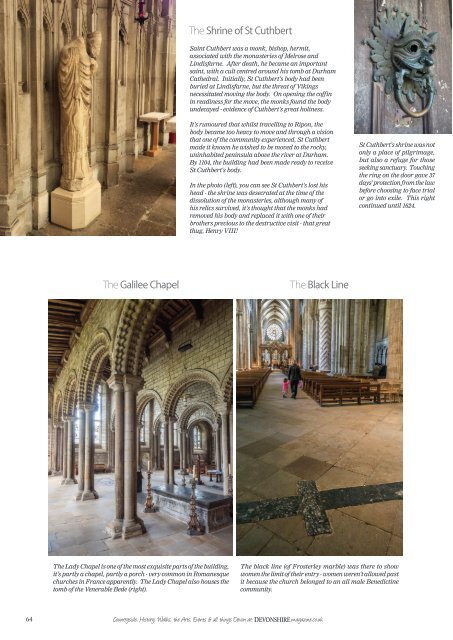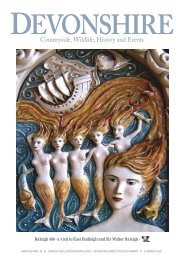Devonshire October November 16
You also want an ePaper? Increase the reach of your titles
YUMPU automatically turns print PDFs into web optimized ePapers that Google loves.
The Shrine of St Cuthbert<br />
Saint Cuthbert was a monk, bishop, hermit,<br />
associated with the monasteries of Melrose and<br />
Lindisfarne. After death, he became an important<br />
saint, with a cult centred around his tomb at Durham<br />
Cathedral. Initially, St Cuthbert's body had been<br />
buried at Lindisfarne, but the threat of Vikings<br />
necessitated moving the body. On opening the coffin<br />
in readiness for the move, the monks found the body<br />
undecayed - evidence of Cuthbert's great holiness.<br />
It's rumoured that whilst travelling to Ripon, the<br />
body became too heavy to move and through a vision<br />
that one of the community experienced, St Cuthbert<br />
made it known he wished to be moved to the rocky,<br />
uninhabited peninsula above the river at Durham.<br />
By 1104, the building had been made ready to receive<br />
St Cuthbert's body.<br />
In the photo (left), you can see St Cuthbert's lost his<br />
head - the shrine was desecrated at the time of the<br />
dissolution of the monasteries, although many of<br />
his relics survived, it's thought that the monks had<br />
removed his body and replaced it with one of their<br />
brothers previous to the destructive visit - that great<br />
thug, Henry VIII!<br />
St Cuthbert's shrine was not<br />
only a place of pilgrimage,<br />
but also a refuge for those<br />
seeking sanctuary. Touching<br />
the ring on the door gave 37<br />
days' protection from the law<br />
before choosing to face trial<br />
or go into exile. This right<br />
continued until <strong>16</strong>24.<br />
The Galilee Chapel<br />
The Black Line<br />
The Lady Chapel is one of the most exquisite parts of the building,<br />
it's partly a chapel, partly a porch - very common in Romanesque<br />
churches in France apparently. The Lady Chapel also houses the<br />
tomb of the Venerable Bede (right).<br />
The black line (of Frosterley marble) was there to show<br />
women the limit of their entry - women weren't allowed past<br />
it because the church belonged to an all male Benedictine<br />
community.<br />
64<br />
Countryside, History, Walks, the Arts, Events & all things Devon at: DEVONSHIRE magazine.co.uk


















